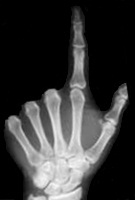Journal Club
February 2010
Physicians' ability to manually detect isolated elevations in leg intracompartmental pressure
Franklin D. Shuler and Matthew J. Dietz J Bone Joint Surg Am. 2010;92:361-367
Reviewed by
Dr Josh Petterwood
MBBS | Accredited Orthopaedic Registrar
Study Type
- Cadaver study investigating the reliability of physical examination in the obtunded patient with compartment syndrome of the lower leg
Location
- Department of Orthopaedics, West Virginia University, Morgantown, West Virginia
Funding
- Sponsored by Stryker
Methodology
- 4 fresh, never frozen cadavers, average age 74.5 yrs
- Uninterrupted fluid column to each leg compartment to generate intracompartmental pressure of 20/40/60/80mmHg
- Either deep posterior or anterior compartment then varied while remaining 3 compartments were given control pressure of 20mmHg
- 20/40mmHg = no compartment syndrome
- 60/80mmHg = compartment syndrome
- 136 separate examinations by local orthopaedic residents/surgeons
- Three questions
- Is there a compartment syndrome?
- In which compartment(s) is the pressure elevated, if at all?
- Describe your examination findings as soft, compressible or firm?
Statistical analysis
- Positive predictive value
- where PPV equals correctly identifying an elevation in compartment pressure and the correct compartment of elevation
- Negative predictive value
- Sensitivity
- Specificity
- Comparison between groups
- Junior residents
- Senior residents
- Attendings
Results
- Overall
- Positive predictive value – 19%
- Sensitivity – 24%
- Specificity – 55%
- Negative predictive value – 63%
- No significant difference with increasing experience
- When investigators removed the identification of the correct compartment as a requisite for PPV and looked only at the correct identification of compartment syndrome the PPV increased to 70%.
- Only 45% of participants described compartments elevated to 80mmHg as firm.
Discussion
- Compartment syndrome typically considered a ‘clinical diagnosis’
- Mostly subjective findings
- Very difficult in the obtunded pt
- Firmness of compartments is ‘objective’
- Clinical exam previously shown to be unreliable (13-19%)
- In this study palpation shown to be a very poor method of determining increases in compartment pressure (in cadavers)
- Choice of pressures
- Control 20mmHg
- Compartment syndrome 60-80mmHg
- One compartment elevated only
- all of which have not been validated nor can be accurately applied to a clinical setting
Strengths
- Numbers
- Well controlled/technically performed for an in vitro study
Weaknesses
- Cadaver study
- Authors draw rather firm clinical conclusions from a cadaver study
Take home message
- Cadaver study – as such no significant clinical conclusion can be drawn
But in general
- High index of suspicion crucial in diagnosis of compartment syndrome
- Serial examination the key
- • Use of manometer is probably under utilised (use early)
Webpage Last Modified:
5 August, 2010



